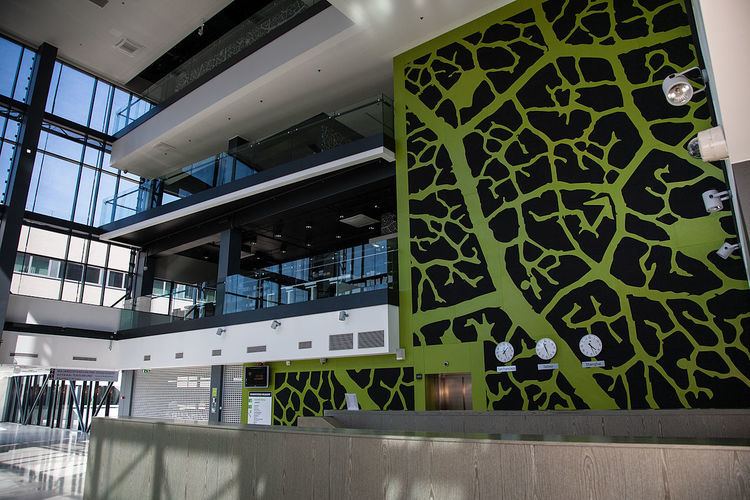Motto in English With wisdom and hands Established 1918 (1918) Undergraduate tuition and fees 3,550 EUR (2017) Mascot Juulius Motto Mente et manu | Rector prof. Jaak Aaviksoo Total enrollment 13,739 (2009) Phone +372 620 2002 Colors Deep Red, Steel Grey | |
 | ||
Academic staff 1 160; international 128 Students 12 000; international 1 400 Notable alumni Tiit Vähi, Jüri Ratas, Katrin Siska, Anne Veski, Tõnis Palts Similar Estonian University of Life Sci, University of Tartu, Tallinn University, Tallinn University of Applie, Estonian Maritime Academy Profiles | ||
Tallinn university of technology programmes in it and engineering
Established in 1918, Tallinn University of Technology (TUT; Estonian: Tallinna Tehnikaülikool, abbreviated TTÜ) is the only technical university in Estonia. TUT, in the capital city of Tallinn, is the nation’s leading academic institution in engineering, business, and public administration. TUT has colleges in Tallinn, Tartu, Kuressaare and Kohtla-Järve. Despite the similar names, Tallinn University and Tallinn University of Technology are separate institutions.
Contents
- Tallinn university of technology programmes in it and engineering
- International relations in tallinn university of technology
- History
- TUT today
- Faculties
- Institutes
- International degree programs in English
- Alumni
- Partner universities
- References
International relations in tallinn university of technology
History
In the early twentieth century, Estonia recognised an urgent need for locally trained engineering specialists. Until then, young people from Estonia had received their specialist education in St. Petersburg, Germany or Riga. Opportunities had to be sought for engineering-minded people to acquire an Estonian-based education which was adapted to local conditions and needs; Estonia was in the process of establishing itself as an independent country.
On 17 September 1918, the Estonian Engineering Society opened an Estonian-based engineering school named Special Engineering Courses. That date has been recognised as the founding date of the Tallinn University of Technology. Programmes were offered in mechanical, electrical, civil and hydraulic engineering, shipbuilding and architecture. In 1919, the school became the private Tallinn College of Engineering, which in 1920 was declared a state institution. Teachers' efforts to develop an Estonian terminology for science and technology proved fruitful and the first engineering books were published. In 1923, the first engineering graduation theses were defended in Estonia. In the same year, a state laboratory of materials testing opened for research work.
By the 15 September 1936 Act of the Head of State, the school was granted university status, and named the Tallinn Technical Institute. The institute had two faculties: civil and mechanical engineering and chemistry and mining. In 1938, the name Tallinn Technical University (TTU) was effective. In 1940 the Faculty of Economics, in 1958 the Faculty of Power Engineering and in 1965 the Faculty of Control Engineering were founded. After 2003 the university was known in English as the Tallinn University of Technology (TUT).
On 1 July 2008, TUT took over International University Audentes (IUA), which became part of the Faculty of Economics and Business Administration, except the Law School which joined the Faculty of Social Sciences. In 2014 an agreement for merger of the Estonian Maritime Academy with TUT was signed.
On 16 November 2016, TUT and the Estonian Information Technology College signed a merger agreement. Since 1 August 2017, the IT College will become a part of TUT.
TUT today
Tallinn University of Technology is a modern, international university teaching the newest knowledge and skills necessary for today’s international and competitive marketplace. With strong emphasis on internationalization, TUT has a strong multicultural student body (there are 1 400 international students from over 80 countries), many international professors (10% foreign staff members), great cooperation with the world's top universities (e.g. Stanford, Technische Universität München, Del University of Technology and KTH Royal Institute of Technology in Europe ) and with international companies (e.g., Microsoft, ABB, IBM, etc.).
There are over 30 fully accredited international degree programmes (4 Bachelor programmes, 18 Master programmes and 10 PhD programmes) that are available fully in English. The cooperation and exchange programmes with world´s top universities provides TUT students chance to study a semester or a year abroad.
A degree from TUT can be the basis for further academic work; graduates of TUT have been admitted to Oxford University, Harvard University, Brown University, University of California Berkeley, the University of London, University of Mannheim, Chalmers University of Technology, KTH, Aalto University, St. Gallen University, University of Southern Denmark and other renowned academic institutions.
TUT conducts world class fundamental and applied research and develops high-tech applications in many fields:
Faculties
Institutes
International degree programs in English
The internationalization of higher education is one of the key strategic goals of Tallinn University of Technology. The university offers over 30 degree programmes in English: 4 Bachelor programmes, 17 Master programmes and 10 PhD programmes.
Bachelor level programmes:
Master level programmes:
Joint Master programmes coordinated by Tallinn University of Technology:
Joint Master programmes coordinated by other institutions:
PhD programmes:
Alumni
Besides the entire technological elite of Estonia, alumni include numerous industrialists and businessmen, including Hardi Meybaum, the CEO and a co-founder of GrabCAD; the Chairman of the Estonian Chamber of Commerce, Toomas Luman; and the former Prime Minister and eminent industrialist Tiit Vähi. The Vice President and former President of the Estonian Academy of Science, Jüri Engelbrecht, is also a member of TUT.
Partner universities
The cooperation, especially with European universities is more focused for curricula development, project cooperation and networking. In Europe, student and staff mobility is mainly organised under Erasmus programme. A selection of university-wide partnerships:
